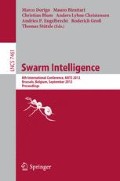Abstract
Aggregation is a widely observed phenomenon in social insects and animals such as cockroaches, honeybees and birds. From swarm robotics perspective [3], aggregation can be defined as gathering randomly distributed robots to form an aggregate. Honeybee aggregation is an example of cue-based aggregation method that was studied in [4]. In that study, micro robots were deployed in a gradually lighted environment to mimic the behavior of honeybees which aggregate around a zone that has the optimal temperature (BEECLUST). In our previous study [2], two modifications on BEECLUST – dynamic velocity and comparative waiting time – were applied to increase the performance of aggregation.
Access this chapter
Tax calculation will be finalised at checkout
Purchases are for personal use only
References
Arvin, F., Samsudin, K., Ramli, A.R.: Development of a Miniature Robot for Swarm Robotic Application. International Journal of Computer and Electrical Engineering 1, 436–442 (2009)
Arvin, F., Samsudin, K., Ramli, A.R., Bekravi, M.: Imitation of Honeybee Aggregation with Collective Behavior of Swarm Robots. International Journal of Computational Intelligence Systems 4(4), 739–748 (2011)
Şahin, E., Girgin, S., Bayındır, L., Turgut, A.E.: Swarm Robotics. In: Blum, C., Merkle, D. (eds.) Swarm Intelligence, vol. 1, pp. 87–100. Springer, Heidelberg (2008)
Schmickl, T., Thenius, R., Moeslinger, C., Radspieler, G., Kernbach, S., Szymanski, M., Crailsheim, K.: Get in touch: cooperative decision making based on robot-to-robot collisions. Autonomous Agents and Multi-Agent Systems 18(1), 133–155 (2009)
Supplementary Data, http://webpages.lincoln.ac.uk/farvin/Supplementary.htm
Vaughan, R.: Massively multi-robot simulation in stage. Swarm Intelligence 2(2), 189–208 (2008)
Author information
Authors and Affiliations
Editor information
Editors and Affiliations
Rights and permissions
Copyright information
© 2012 Springer-Verlag Berlin Heidelberg
About this paper
Cite this paper
Arvin, F., Turgut, A.E., Yue, S. (2012). Fuzzy-Based Aggregation with a Mobile Robot Swarm. In: Dorigo, M., et al. Swarm Intelligence. ANTS 2012. Lecture Notes in Computer Science, vol 7461. Springer, Berlin, Heidelberg. https://doi.org/10.1007/978-3-642-32650-9_39
Download citation
DOI: https://doi.org/10.1007/978-3-642-32650-9_39
Publisher Name: Springer, Berlin, Heidelberg
Print ISBN: 978-3-642-32649-3
Online ISBN: 978-3-642-32650-9
eBook Packages: Computer ScienceComputer Science (R0)

